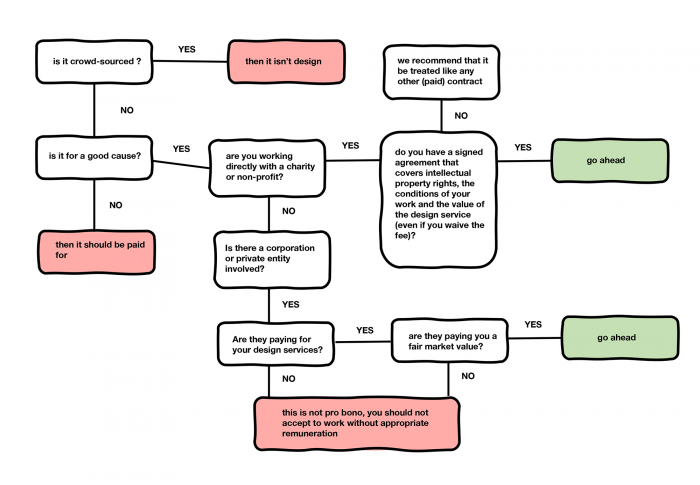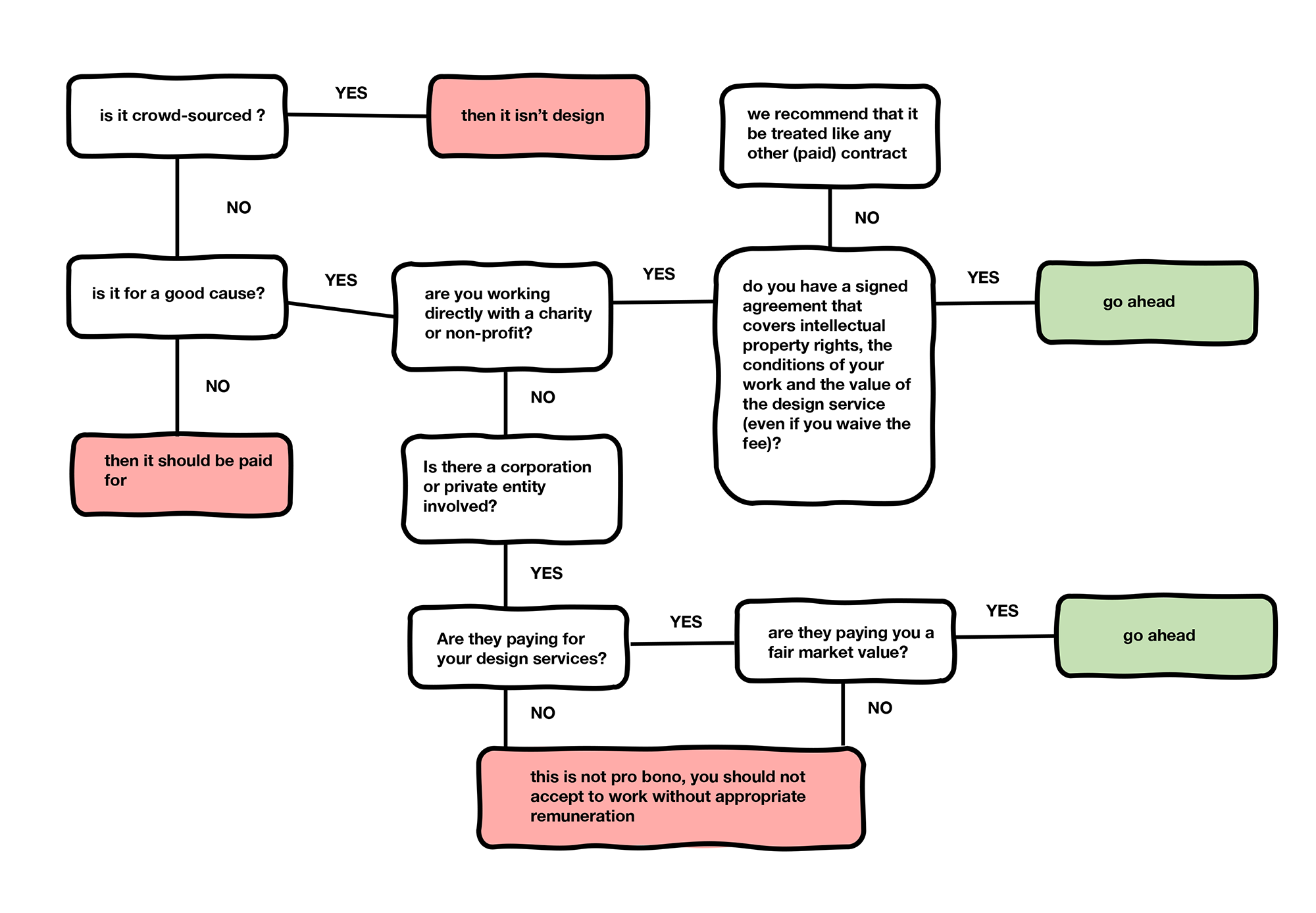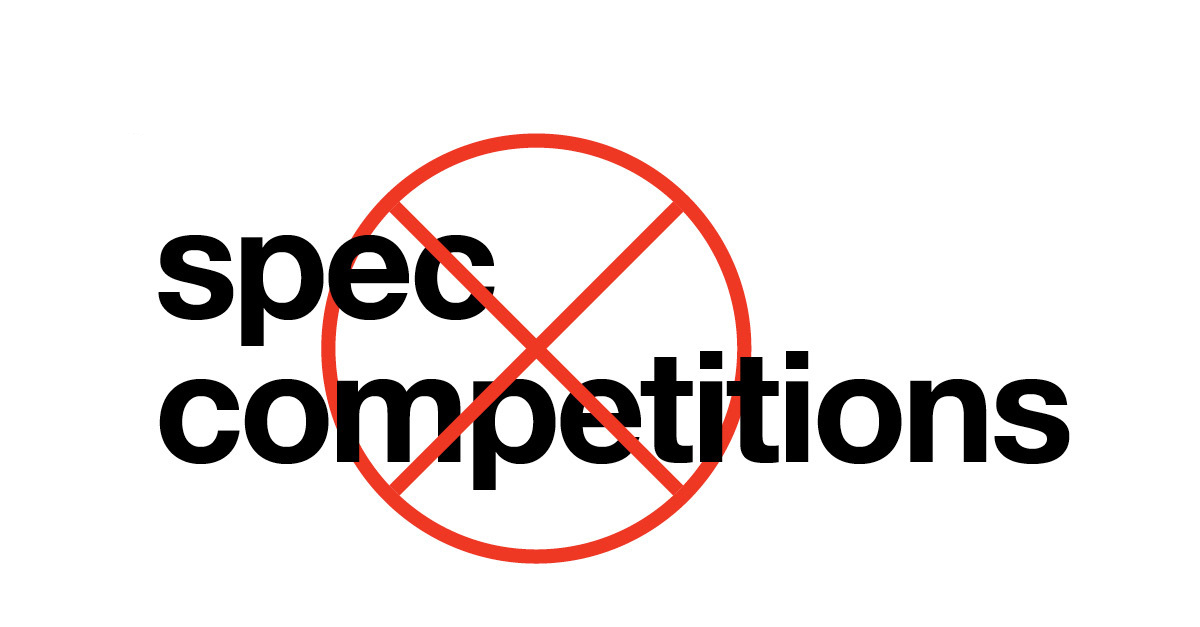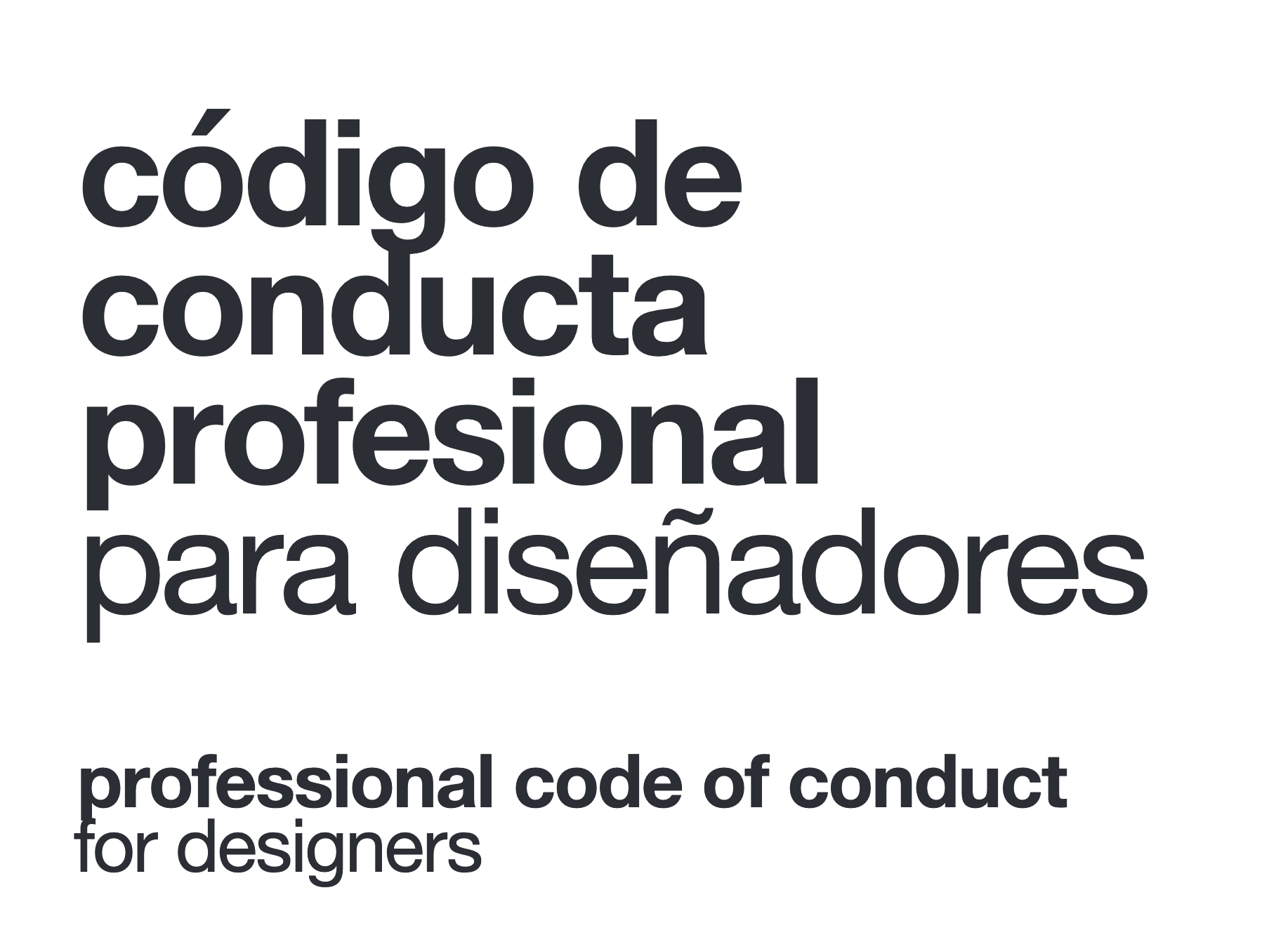the 'pro bono' primer

11.05.2022 Professional Practice
As professionals with a desire—and we would argue, obligation—to improve the quality of life of other humans, designers are urged contribute their capacities for the greater good. But when it comes to Pro Bono design, the line between designing for free, and ‘for good,’ isn’t always clear. Here’s a quick guide on navigating Pro Bono design.
In this article, we attempt to define the appropriate circumstances under which Pro Bono design work—meaning, design ‘for good’—can be undertaken.
The Council created this infographic to help designers navigate the complexities of designing Pro Bono. Feel free to copy and keep in your files!
BASIC REQUIREMENTS
The Latin pro bono does not—as it is often misunderstood – mean ‘for free’; it means ‘for good,’ in contribution to a worthy cause. Pro bono contributions by designers are encouraged by our organisation. Professional design work, following the design process, contributes to the work being adequately valued even if it is not remunerated in the traditional way. This must be negotiated by the contributing designer.
There are two basic measures then, for determining if a work is in fact Pro Bono design work:
✔ It must be for a good cause. It should be made clear who is benefitting from the 'donated' work and what need is being met. Legitimate causes deserving of Pro Bono contributions serve primary objectives which are philanthropic and promote social well-being, such as educational, religious, sustainable, and other activities serving the public interest or common good. It is not legitimate to contribute to a profit-driven corporate entity or an industry group.
✔ It must be design work.
‘Crowd-sourcing design’ is an oxymoron. The interaction between the client and the designer, between potential users and the designer, and the process of iteration that happens between them, is a fundamental part of the design process. What is being asked of designers in crowd-sourced design contests is in fact something that approximates 'design' but is not professional practice. In so doing, crowd-sourced contests degrade the value of design and erode the esteem of designers with the very industry that they are trying to impress. For more on speculative design contests, design challenges and other forms of crowd-sourced design, see our article here.
THE 'GOOD CAUSE' CHECKLIST
✔ Can you identify who is profiting directly from your work?
You can also contribute Pro Bono to an individual or to an informal group. If you can see and work directly with the people who are benefitting, it is legitimate. If there is a third-party group mediating the relationship, you will need to look further.
✔ Are you working directly with a charity or non-profit entity?
In cases where a designer is working directly with a charity or non-profit, following the traditional client-designer model (where an agreement is defined, intellectual property rights are attributed and the value of the service 'donated' is defined), then it is up to the individual designer to determine if they feel the cause is worthy of their time.
❌ Is there profit-driven corporate entity or private entity involved?
If the answer to this question is 'yes' the case for Pro Bono usually cannot be made. Whether the corporate or private entity is asking designers to contribute their work to the corporate entity or to a third-party foundation or charity they choose to support, the entity is profiting from the 'donation' either directly, or indirectly, through the positive public relations, social media coverage or other.
❌ Is the profit-driven corporate entity or private entity involved paying for the design services?
If there is full market-value compensation of the designer's work then this is not Pro Bono work but it is professionally acceptable. If the payment is partial, expecting the designer to 'kick-in' some portion as a donation, this does not qualify as Pro Bono work.
❌ What if the profits are being donated to a charity?
Traditionally, a corporate sponsor's contribution to a fundraiser is to donate the funding that would cover the costs of the fundraiser—including design work. The sponsor benefits from the positive publicity of the association. This tradition has slowly eroded. Nowadays, it is common to ask designers and other suppliers to work for free in exchange for 'publicity' or 'exposure'. To accept to work under these conditions is considered by the Council to be unprofessional and unethical. Not only is this disingenuous on the part of the private entity, the net effect is to undermine the value accorded to design services in general.
Concretely, the company running the competition is using the money they are saving by not paying for the design services that they are contracting. They do this to to generate income and then use the income they generated (off the back of designers who donated their work, remember) to donate their profits—because it is usually the profits not the revenue—to a charity. Taking the credit for themselves, such companies use the promotional value of the donation to build their brand. The charity wins, the corporate entity wins, but the designer loses. Normalising this type of scheme is detrimental to the respect and value of the design profession.
CONDITIONS OF WORKING PRO BONO
If you have confirmed that the work meets the criteria for good cause and you have chosen to donate your professional talents, there is one final condition that should be met to ensure that this is done professionally. The conditions of the working relationship between the designer and the recipient should be carefully determined, defined, and described in an agreement. The conditions of undertaking Pro Bono work—including the adherence to design methodology, the ensuing ownership of rights and expenses—should be delineated and respected. The value of the design services rendered should be communicated clearly to the Pro Bono recipient. It is preferable to accord a value to the service and waive the fee than to simply not discuss the financial worth. Cost and perceived value are closely tied. It is the responsibility of every designer to maintain the perceived value of the practice through their ethical professional conduct.
Comments or questions about this article? Please contact Ana Masut at director@theicod.org.
LEXICON
PRO BONO: It is widely misunderstood that the Latin ‘pro bono’ means ‘for free’. In fact, the term means ‘for good.’ To work to advance a deserving cause is encouraged. However, the precise working relationship between the designer and the recipient should be carefully determined, defined and described in an agreement. The conditions of unremunerated work, including ownership of rights, should be adhered to strictly. The value of the design services rendered should be communicated clearly to the Pro Bono recipient.

relatedarticles

VIDEO: why professional designers should not participate in spec competitions

resources for displaced designers

professional designers do not participate in spec competitions

